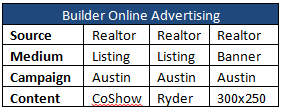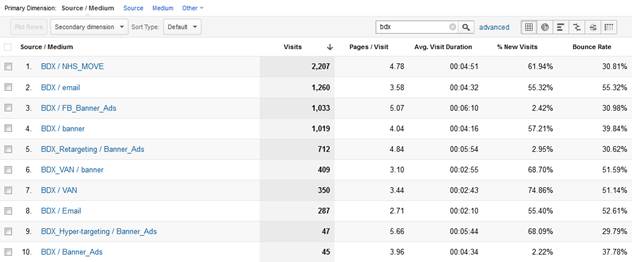 By Thane Tennison, Advertising Manager, BDX
By Thane Tennison, Advertising Manager, BDX
One of the greatest benefits of online advertising is the ability to track performance and make data driven decisions. As a marketer these data points allow you to qualify performance, optimize spend and manage ROI. However, without the proper tracking elements in place before you begin, it can be much harder to understand which advertising channels are driving the greatest value.
There are lots of software solutions to help online marketing managers track and analyze performance including Omniture, Webtrends, and Google Analytics; most of the builders we work with have Google Analytics installed. The service is free and automatically integrates with other Google services such as paid search. Google UTM Tracking Codes allow marketers the ability to track activity from third party sites like listings on NewHomeSource or a banner campaign. Tracking URLs are quick and easy to set up and can provide a wealth of information regarding performance of listings, banners, emails and more. At BDX, we’re a strong advocate of implementing tracking not only to help our clients highlight performance, but also to help us improve our products and services.
The following is how you can implement tracking codes and keep them organized.
I recommend keeping a consistent naming convention. This will pay dividends when you want to look at performance over a long period of time or when comparing two different channels. Google’s UTM codes are case sensitive so “BDX_listings” and “bdx_listings” can appear as two separate line items and distort actual performance. A consistent naming convention will also help keep things organized. Having some campaigns labeled “Banners” and others “Display” will create a lot of extra work when reviewing performance.
WHAT TO TRACK:
Campaign Source: Where are you receiving your traffic? For builders this could be from BDX, Realtor.com, NHSPro, Zip Realty, Trulia, Zillow etc. Keeping the source consistent will also help you understand the services you have with each product. For example, if you have listings with BDX as well as a banner campaign you’d want keep the source for both as “BDX.”
Campaign Medium: The medium is the type of service. Listings, banner, email are the most common mediums used by builders. By consolidating into these three buckets it’s easy to compare performance of all your banner campaigns or traffic from all or your listing services.
Campaign Name: The third level of segmentation helps you differentiate creative and offers. If you’re running the same art across multiple networks this field should be the same for each network. Many builders who advertise across multiple markets will identify the market here. It makes for any easy filter when you want to compare performance for a particular division.

Campaign Content: If you’re doing A/B testing between offers or have multiple links from the same source you could use the content filter to drill into performance for each link. For example, if you wanted to differentiate incoming traffic from Realtor.com listings vs. the Realtor.com Ryder Sign, you could differentiate using the “content” field. For advertisers who want to review ad performance by size I’d also recommend this field.

As a marketing manager, you’ll need as much information as possible to manage and optimize performance and I would recommend adding UTM tracking to every link and paid media source. However, starting with a plan and maintaining a clear naming convention will make it easier to review performance year over year and allow for greater and easier segmentation.
Below is an example of how I would set up some common links used at BDX.

With tracking codes in place, you will be better equipped to make the smart decisions and optimize for a better ROI. For example, you might find that you’re getting a great rate and a lot of traffic from one advertising vendor but the traffic tends to have a high bounce rate and those consumers don’t convert into home sales while other more expensive channels drive more value and therefore may have a better return. You may decide you want to test a new marketing initiative and need an established benchmark to gauge success and justify the program.
 If you have questions about setting up tracking links or creating campaign goals in Google Analytics please feel free to contact me.
If you have questions about setting up tracking links or creating campaign goals in Google Analytics please feel free to contact me.
Thane Tennison is the Advertising Manager for the BDX and manages hundreds of home builder brands across a network of over a dozen real estate websites.

 By Ryan Folgate, BDX Advertising Coordinator
By Ryan Folgate, BDX Advertising Coordinator  By Builders Digital Experience
By Builders Digital Experience By Jamie Lintner, Advertising Accounts Manager, BDX
By Jamie Lintner, Advertising Accounts Manager, BDX
